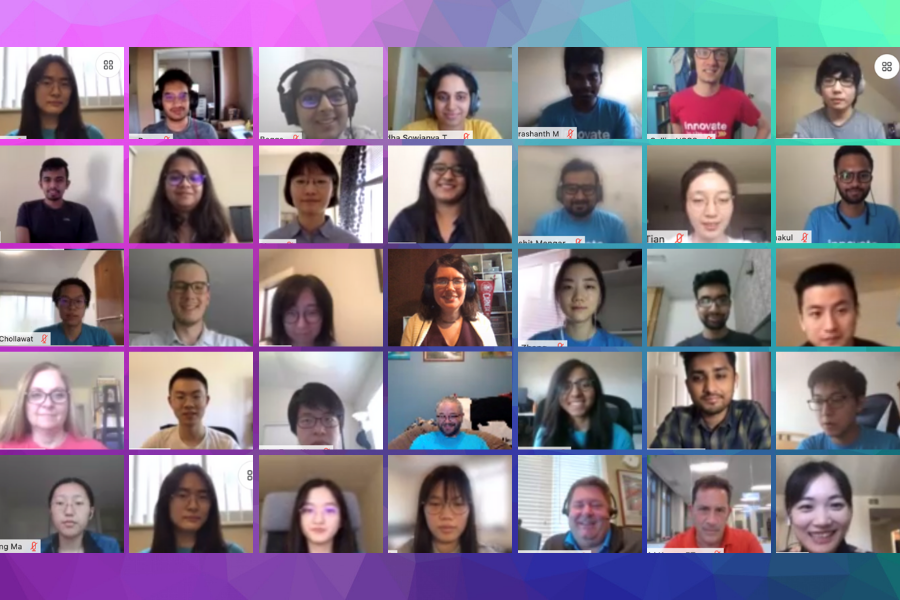
Showcasing Practicum Projects at CMU Silicon Valley
By Jessica Shirley
& Deana Lorenzo
Throughout the fall 2020 semester, Information Networking Institute (INI) bicoastal master's students have innovated in the wild through practicum projects sponsored by tech companies, startups and government agencies. At this virtual event, INI students will showcase their practicum work in computing, mobile systems and security through dynamic presentations and project exhibits.
Thank you to our sponsors!
Carnegie Mellon University
Ethical Intruder
NASA
National Security Agency
Procter & Gamble
SLAC National Accelerator Laboratory
T-Mobile
U.S. Geological Survey
Fall 2020 Projects
CMU: Building Browser-Based Data Tools
In 2020, the California Consumer Privacy Act (CCPA) was enacted, which enables California residents to opt out of having their data sold or "shared" with other companies online. To make it easier for consumers exercise their rights, this team seeks to design, build and test a browser extension that sends HTTP header signals requesting companies to fulfill CCPA obligations.
Team: Xiaofei Ma, Bingxuan Luo, Maggie Feng, Zeeshan Sadiq Khan and Arjita Mahajan
CMU: Coordinating Home Health Visits in the COVID-19 Pandemic
Due to COVID-19, telemedicine is quickly replacing in-person clinic visits. However, many conditions still require physical examinations or hands-on intervention, which can be provided through in-person home visits by medical providers. The goal of this project is to efficiently and adaptively schedule providers to these home visits to minimize provider travel time, while ensuring that all patients can be seen.
Team: Kuixi Song, Xiansheng Zhu, Prashanth Mogali, Yue Xu, Jing Ma and Zihan Cao
CMU: Security Analysis of Home IoT Systems
One of the most significant challenges to securing smart home IoT systems is that users deploy devices from multiple vendors or service providers, and no single entity is able to monitor all of the activity in a home. Instead of relying on individual vendors, this team seeks to develop independent monitoring, analysis, detection, and visualization tools that can view the IoT system holistically, including aspects of wireless, network, device, OS, and application security.
Team: Yinuo Du, Karthik Ashwath, Tharasa Vudi and Zuotian Li
CMU: Humanizing Tele-Education with Machine Vision
In tele-education, lecturers need to be able to ascertain student engagement. Unfortunately, this can be difficult in a remote setting, as lecturers often have a limited view of their audience. This project will investigate and develop machine vision techniques for alleviating this problem.
Team: Bryan Tulshi, Jiaan Lu, Yizhuo Zhang and Haitong Yu
Ethical Intruder: Automated Penetration Testing Attack Selection Framework
Manual penetration testing is often a time consuming and complex engagement due to the amount of planning and analysis that is required to successfully select and execute the most appropriate attacks for a specific environment and scenario. This project aims to use machine learning to make that process more efficient and effective through automation.
Team: Shakul Ramkumar, Yue Geng, Arjun Singh Brar and Yanjun Zhou
NASA: Detection of Anomalies in Flights Using Explainable Deep Generative Models
Airlines capture and analyze real-time flight data to log known events, but whether this data may also capture significant unknown safety events is not currently being tracked. The goal of this project is to develop an explainable machine learning model to detect and/or predict anomalies that could lead to adverse events using high-dimensional and heterogenous time series recordings of airspace operation.
Team: Sarthak Munshi, Vishesh Goyal, Xingying Ma, Kartik Chaudhari and Radha Sowjanya Tangirala
NASA: Simulation, Modeling, Visualization, Algorithms, and Data Analysis for Improving Airport Surface Operations
Airport surface operations present a difficult, large-scale logistics problem requiring multi-criteria optimization. This project proposes to investigate this problem, specifically the movement of aircraft at a busy airport, to improve efficiency and avoid serious delays by automating some of the decision-making process, such as ordering pushbacks from gate, runway assignment and wait times.
Team: Qianling (Shirley) Su, Yurui Wang, Yi Wang, Yao Lu, Chengyongping Lu, Shuang Weng and Ruchira Padal
National Security Agency: Internet-of-Things Data Fusion
As their proliferation increases, Internet-of-Things (IoT) devices continue to generate more data and new types of information. Such devices are increasingly used by personnel in military installations, creating digital dust that presents a growing operational security concern for National Security Agency and Department of Defense organizations. This project team seeks to better understand how different IoT datasets could interact with each other and provide intelligence to adversaries.
Team: Nishit Mengar, Siqing (Eko) Yang, Arezu Mansuri and Sai Vamsi Krishna Medishetty
Procter and Gamble: Serverless SIEM/Log Management Solution
As a multinational company, P&G has Security Operations Center (SOC) teams that rely on SIEM (Security information and event management) systems to collect and aggregate event logs from across the enterprise to analyze and respond to security incidents. However, SIEM solutions have been expensive and difficult to scale. Therefore, this project team seeks to design and implement a scalable SIEM based on the existing cloud service infrastructure.
Team: Divyansh Arora, Pengyun Zhao, Yuting Liu, Yihua Cai, Sijie Lin, Linqing (Robert) Li and Victor Otazu
SLAC National Accelerator Laboratory: Blockchain for Optimized Security and Energy Management (BLOSEM)
To solve the greatest challenges around renewable penetration and grid resilience, we need data sovereignty, starting with a unified, secure identification framework for all grid assets as well as behind-the-meter smart devices. This team proposes to develop a blockchain-based registry of traditional grid assets and emerging smart devices, and demonstrate the system at scale with industrial control system infrastructure.
Team: Chollawat Jiramethathorn, Rui Zhang, Xinrui Nie and Dhairyya Agarwal
SLAC National Accelerator Laboratory: DEVINE - Demonstration of Vehicle-Grid Integration in Non-Residential Environments
While increasing the implementation of electric vehicles (EV) is a major step towards a cleaner transportation sector, it can also create additional demand and grid stress if EV loads are not managed correctly. DEVINE is a tool being designed to help address these issues by utilizing EV charging data. In this project, students will evaluate the existing design of the DEVINE infrastructure and build out data exploration interfaces.
Team: Yiwen Tang, Zhongyan Huang, Jiayi Zhang, Zixiong Zhang, Jiaqi Liu, Chen Mo and Anita Poulose
T-Mobile: Mobile Peer-to-Peer Blockchain Enabled Sharing (MP2P-BES)
The goal of this project is to develop a Peer-to-Peer Prototype that provides network access and secure public peer-to-peer sharing of mobile device resources. The major components include a blockchain technology-based engine, smart contract policy enforcer module, peer to peer protocol, hotspot tether slice resource module, private ledger engine, and peer-to-peer subscriber database.
Team: Yawei Zhang, Viha Gupta, Diti Bagga, Jianan Shen, Jiasheng Zhou and Sri Harsha Yayi
United States Geological Survey (USGS): Geospatial Data Visualization for Optimizing Vehicle Routing in Land Gravity Surveys
The acceleration due to gravity is not the same everywhere on Earth. Mapping these variations in the Earth’s gravitational field allows scientists to explore for energy and mineral resources and to map faults in earthquake-prone areas. The student team built an interactive data visualization tool that allows scientists to better understand spatial variations in the Earth’s gravitational field and to identify the highest priority areas for collecting new gravity data.
Team: Ziwei Cheng, Yuqing Wen, Fanghan Lei and Hsin-Han Wu
